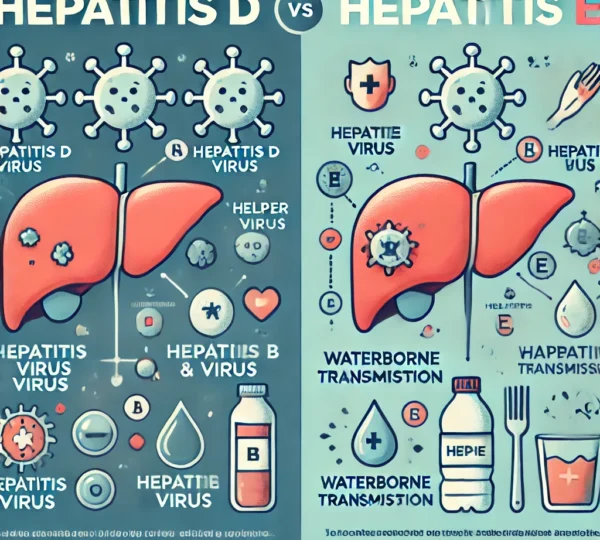Hepatitis D and E: Lesser-Known Types Explained
When it comes to hepatitis, we often hear about types A, B, and C. However, there are lesser-known types, hepatitis D and E, that deserve attention. Let’s delve into these two unique viral liver infections to understand their causes, risks, and prevention strategies.
Hepatitis D (HDV): The “Helper” Virus
Hepatitis D, or delta hepatitis, is unique because it can only infect people who already have hepatitis B. HDV relies on hepatitis B to replicate, which makes it a “helper virus.” This combination can lead to more severe liver disease than hepatitis B alone and increases the risk of liver failure.
Symptoms of Hepatitis D
- Jaundice (yellowing of the skin and eyes)
- Abdominal pain and swelling
- Fatigue and nausea
- Dark urine
- Muscle and joint pain
Prevention and Management of Hepatitis D
Since HDV depends on hepatitis B for survival, vaccination against hepatitis B is the primary prevention method. Although there is no specific treatment for hepatitis D, managing hepatitis B can lower the risk of complications.
Long-tail keywords added:
- “how to prevent hepatitis D virus infection”
- “vaccination to prevent hepatitis D transmission”
- “severe liver disease risks with hepatitis D”
Hepatitis E (HEV): The “Waterborne” Virus
Hepatitis E primarily spreads through contaminated water or food, especially in regions with limited sanitation facilities. While similar to hepatitis A, HEV is more prevalent in developing countries and can cause outbreaks, particularly after natural disasters. Pregnant women, especially in their third trimester, are at higher risk of severe complications.
Symptoms of Hepatitis E
- Fever and fatigue
- Loss of appetite
- Nausea and vomiting
- Abdominal pain
- Jaundice
Prevention and Management of Hepatitis E
Preventing hepatitis E involves access to clean drinking water, maintaining proper hygiene, and being cautious when traveling to high-risk areas. Most hepatitis E cases resolve independently, but severe cases may require medical care. Pregnant women should be especially vigilant, as they are more prone to complications.
Long-tail keywords added: 4. “how to prevent hepatitis E when traveling” 5. “importance of clean water for hepatitis E prevention” 6. “symptoms of hepatitis E in pregnant women” 7. “natural disaster impact on hepatitis E outbreaks” 8. “hepatitis E complications in third trimester pregnancy”
Conclusion
While hepatitis D and E are less familiar than types A, B, and C, they pose significant health risks in certain populations and regions. By understanding their transmission methods and preventive measures, we can better protect ourselves and promote liver health globally.
Long-tail keywords added: 9. “difference between hepatitis D and E infections” 10. “how to manage hepatitis D and E symptoms effectively”
To seek medical advice, always consult a Doctor. Here are our recommended experts. Click here
To read more on Respiratory disease . Click Here



